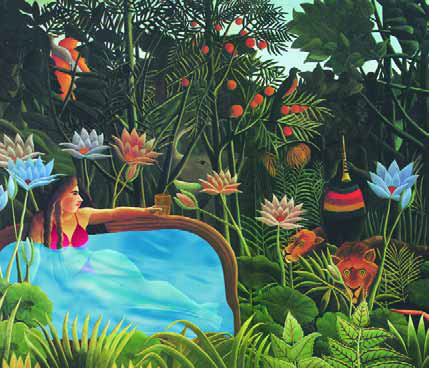water in motion
For me, hitting the high notes in watershaping and landscape design is a product of careful observation, boundless imagination and detailed visualization. These factors drive the design process, after which I transition into the more practical phases of the project with reliable engineering and quality construction. The early, creative phases can definitely be tricky, because they require many of my clients to take great leaps of faith, especially when what they're after is a highly customized environment - something truly unique. In those cases, we know that we at Artisan Home Resorts (San Jose, Calif.) are asking clients to visualize something nobody's ever seen before: No matter how well we represent our ideas on paper or on a computer screen, the outcome will, to a certain degree, remain an abstraction until the everything is finished and working. When everything finally comes together (as we believe it did in the project illustrated in this feature), a vision is realized and the payoff can be extremely rewarding, both for the clients and for those of us who worked hard to see the process through. Here as in few other projects we've done, however, even we weren't precisely sure how
For me, hitting the high notes in watershaping and landscape design is a product of careful observation, boundless imagination and detailed visualization. These factors drive the design process, after which I transition into the more practical phases of the project with reliable engineering and quality construction. The early, creative phases can definitely be tricky, because they require many of my clients to take great leaps of faith, especially when what they're after is a highly customized environment - something truly unique. In those cases, we know that we at Artisan Home Resorts (San Jose, Calif.) are asking clients to visualize something nobody's ever seen before: No matter how well we represent our ideas on paper or on a computer screen, the outcome will, to a certain degree, remain an abstraction until the everything is finished and working. When everything finally comes together (as we believe it did in the project illustrated in this feature), a vision is realized and the payoff can be extremely rewarding, both for the clients and for those of us who worked hard to see the process through. Here as in few other projects we've done, however, even we weren't precisely sure how
Who took the water out of watershapes? That may seem a ridiculous question, but it's also an obvious one when you see as many plans as I do - and by that I mean plans intended to indicate and initiate the watershaping parts of a wide variety of projects. Indeed, in my long experience in running an engineering-oriented firm, I've repeatedly been asked by designers to flesh out their watershape "ideas" (although in most cases vague inklings would probably be a more accurate way to describe them) and provide working drawings that reflect their "thinking." In my estimation, more than three-quarters of these plans lack any real indication of what the designers expect the water to do or how they want it to look. Instead, what I get is the typical overhead views with the ubiquitous "blue ghosts" or, in some cases, rudimentary sections of structures designed to contain water. It's left to me to probe and ask questions and determine what expectations they have about how the water is to appear and what it is to do. I've endured these common plan shortcomings for more years than I care to count, always wondering
Who took the water out of watershapes? That may seem a ridiculous question, but it's also an obvious one when you see as many plans as I do - and by that I mean plans intended to indicate and initiate the watershaping parts of a wide variety of projects. Indeed, in my long experience in running an engineering-oriented firm, I've repeatedly been asked by designers to flesh out their watershape "ideas" (although in most cases vague inklings would probably be a more accurate way to describe them) and provide working drawings that reflect their "thinking." In my estimation, more than three-quarters of these plans lack any real indication of what the designers expect the water to do or how they want it to look. Instead, what I get is the typical overhead views with the ubiquitous "blue ghosts" or, in some cases, rudimentary sections of structures designed to contain water. It's left to me to probe and ask questions and determine what expectations they have about how the water is to appear and what it is to do. I've endured these common plan shortcomings for more years than I care to count, always wondering
I've always been fascinated by the concept of urbanism as defined by Thomas Jefferson: He boiled it down to the notion that everyone should have his or her own private space as well as a buffer against the outside world. In a sense, the physical concept of the front yard fits perfectly within Jefferson's utopian ideal. At root, it's an ingenious setup that has probably endured for so many centuries because, on some level, it addresses our primal need to have land all around us. By the very configuration of our residential spaces, we each have a small, open, pastoral area that separates the privacy and sanctity of the home from adjacent public areas, sidewalks and streets. The problem is that in many modern cities and suburbs, the amount of room allocated for front yards in particular has dwindled as property values have soared and lots have become smaller and more tightly packed as a result. And when you combine that spatial shrinkage with the increased desire for safety and privacy on the part of many homeowners, it all works together to place ever-higher premiums on how we choose to make use of our small slices of front-yard land. To my mind, this dynamic set of trends
What makes for a great natural-style watershape? That's a huge question - one which a great many people have devoted their careers to exploring and for which almost every one of us will have a slightly different answer. As you will see here, my own response to the question starts with even more questions about the site, my clients and the surrounding structures and vegetation - questions I ask myself as I approach each individual design assignment and decide how far
It's an age-old paradox, this relationship between art and science. On the face of it, things artistic may seem solely the realm of high-flying thinkers and philosophers who spend their days at the far reaches of interpretation and meaning. By contrast, engineers and scientists would seem to be dealing purely in the certainties of what is quantifiable and real. The truth is, I don't know of a modern art form that doesn't involve technology of some kind. Conversely, most branches of modern science call upon researchers to apply a great deal of intuition and creativity to the processes of exploration and discovery. In other words, neither the arts nor the sciences could exist without ideas and disciplines derived from the other. That's especially true when it comes to water systems. Whether created for aesthetic or recreational purposes, art and science can come together here in a particularly compelling and interesting way. By combining technical disciplines with
Throughout my entire working life, I've never moved too far away from the water. From my early days as a pool manager (beach bum) at a resort hotel in Miami Beach through many years in pool service and still today, I've always worked and played in and around water. Whatever it is about bodies of water that infects people's spirits and pushes their internal fun buttons, I have it bad: I love to sail, fish and snorkel, I like living near bodies of water and I just love to look at water. On top of all that, I'm a Pisces. If there's one thing I find that I tend to have in common with my customers, it's this passion for things aquatic and the pleasures that come along with them. This is powerful stuff, and I've come to believe that our innate fascination rises to an even higher level of drama and interest when




















